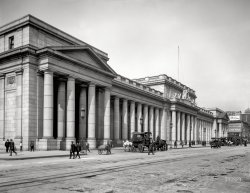
MAY CONTAIN NUTS

Search Shorpy
SHORPY ART

Framed or unframed, desk size to sofa size, printed by us in Arizona and Alabama since 2007. Explore now.
Join and Share
Ad-Free Shorpy
Shorpy is funded by you. Patreon contributors get an ad-free experience.
Learn more.

Recent comments
- Freeze Frame
- Texas Flyer wanted
- Just a Year Too Soon
- WWII -- Replacing men with women at the railroad crossing.
- Yes, Icing
- You kids drive me nuts!
- NOT An Easy Job
- I wonder
- Just add window boxes
- Icing Platform?
- Indiana Harbor Belt abides
- Freezing haze
- Corrections (for those who care)
- C&NW at Nelson
- Fallen Flags
- A dangerous job made worse
- Water Stop
- Passenger trains have right of way over freights?
- Coal
- Never ceases to amaze me.
- Still chuggin' (in model form)
- Great shot
- Westerly Breeze
- For the men, a trapeze
- Tickled
- Sense of loneliness ...
- 2 cents
- Charm City
- What an Outrage
- Brighton Park
Member Photos
The Shorpy
Print Emporium
Print Emporium
Search Shorpy
Search results -- 30 results per page
- Sign of the Cross: 1940
- ... take note!
(The Gallery, Agriculture, Jack Delano, Railroads) ... Posted by Dave - 04/30/2021 - 1:23pm -
![Sign of the Cross: 1940 July 1940. "Negroes from Florida and Georgia who travel by car and truck, following the potato crop northward. Migratory agricultural worker has his supper (a nickel pie and a glass of milk) at the railroad crossing at Camden, North Carolina." Medium format acetate negative by Jack Delano for the Farm Security Administration. View full size.
Pie the wayThe young fellow in the foreground looks as if he's posing for an advertisement. His pose, his face, the pie and the milk - - they combine to look as if they are tempting the viewer to indulge, although I'm unsure if the ad would be for milk or pie. By the way, that's a generous slice of pie for a nickel.
[A "nickel pie" is an entire small pie, not a slice. - Dave]
Locomotive TireThat heavy ring protecting the crossing signal is a worn out steam locomotive tire.
Locomotive tires were heated with a circular gas burner to expand them, then shrunk onto the cast driver center. They tended to wear to a hollow tread contour rather than the correct slightly conical surface, which should have a specific fillet radius to the flange. Every time a locomotive spun its wheels, the tires were wearing out of contour.
The tires could be turned a couple times, like brake disks or brake drums, but then were discarded to be melted down. This one escaped the furnace, and makes a nice seat, although usually too hot or too cold.
Also interesting how little grade crossing signals have changed in 81 years.
Model railroaders, take note!
(The Gallery, Agriculture, Jack Delano, Railroads)](https://www.shorpy.com/files/images/SHORPY-8c02723a.thumbnail.jpg)
- Allwite Morning: 1942
- ... enough to share.
(The Gallery, Marjory Collins, NYC, Railroads) ... Posted by Dave - 01/28/2014 - 12:25pm -
![Allwite Morning: 1942 September 1942. "New York. Third Avenue elevated railway station in the Seventies at 8:30 a.m." America's Favorite at the "Guess It" scales. Photo by Marjory Collins for the Office of War Information. View full size.
Same as it ever wasThere is still a hardware store at 1573 Third Avenue.
Wankel Hardware - since 1896.
Wankel's hardware"The same family since 1896" http://www.wankelshardware.com/
Next stopThe sign on the opposite platform suggests that this isn't in the 70s, but is instead the 89th St. station.
[More like 83rd. -tterrace]
It's a bit blurry & might look like "83rd," but I don't think that's right, for 2 reasons. First, 1573 Third Ave (Wankel's Hardware) is between 88th & 89th. Second, there wasn't an 83rd St stop, but there was one at 89th.
89th Street stationIt's the 89th Street station, looking south from the downtown platform. If it weren't for the people on the platform blocking the view we'd be able to see the platforms of the 84th Street station a bit further down the line. There aren't a lot of photos of 89th Street online, here are a few:
http://www.nycsubway.org/perl/showpix?nsta=311146
No, the steam locomotive in the last photo is not a mistake; the Third Avenue El used steam traction for the first few decades after it opened in 1878.
89th Street closed along with the rest of the Third Avenue El in Manhattan in 1955. It wasn't needed anymore, as people soon would be able to ride a modern subway a block away on Second Avenue, and ... oh wait.
BlackoutSince the United States had entered World War II by this date, I assume the lightbulbs in the overhead fixtures were special blackout bulbs that only allowed a small amount of light to be directed downward. There is a story here about these lightbulbs.
A Finer, Richer WhiteCleans and Makes All White Shoes WHITER!
I see others found the locationbut I think it deserves a current pic. That hardware store is beautifully painted.
View Larger Map
I should have been born earlierI admire how stylish women in the 40's were!
Shorpy brings me home!That is definitely the corner of Third Avenue and East 89th Street -- I lived about 50 yards west of that spot for several years.
I always marveled to imagine the long-gone elevated station and how different my corner used to look.
Wankel's Hardware is a neighborhood mainstay that maintains a wonderful commitment to hiring developmentally challenged people. In a city where many "hardware" stores really aren't, I always valued having it nearby. I'm glad to see the store getting a little moment in the long-ago sun on Shorpy.
1950sBefore I was born, in the 1950s, my dad owned a restaurant under the 3rd Ave El line, I believe it was the 76th Station on one of the corners. I saw a photo of the store front once among the large photo collection of my parents. I need to go through the photos one day soon to see whether the photograph is noteworthy enough to share.
(The Gallery, Marjory Collins, NYC, Railroads)](https://www.shorpy.com/files/images/SHORPY_8d22149a.thumbnail.jpg)
- Vintage Vista: 1901
- ... razed in 1964.
(The Gallery, D.C., D.C. Street Survey, Railroads) ... Posted by Dave - 09/17/2020 - 11:42pm -
![Vintage Vista: 1901 This image is but one section of 10-part panorama, described by the caption below. Some (or even all) of the points of interest mentioned may not be visible here.
Washington, D.C., circa 1901. "Aerial view over rowhouses from old Providence Hospital, showing E Street, Heckman Street [now Duddington Place] and F Street S.E. between 1st and 2nd." 8x10 inch glass negative, D.C. Street Survey Collection. View full size.
Where was the old hospital?Been playing with the maps for 45 minutes. Been pulling my hair out. I need a Shorpy pro.
[Try Google. - Dave]
"Old" Providence HospitalThe photo was taken from the roof of the "old" Providence Hospital which was located at 2nd & D streets SE on Capitol Hill. I was born there in 1950.
In the 50s, a "new" Providence Hospital was built several miles north at 1150 Varnum St. NE. The old hospital was torn down, but unlike many places in close-in SE and SW DC which succumbed to monolithic government buildings and urban renewal, the site became Providence Park. It still exists and can be found on Google Maps adjacent to Folger Park.
More history can be found here.
Alas, even the "new" Providence Hospital has met its fate -- it closed its doors in 2019 after 158 years of service.
Providence ParkI believe that where the hospital was is now Providence Park. The row houses on E, F, Duddington, 1st and 2nd are still there, and look very nice.
Chim Chiminey III used that caption title once before a long time ago, thus the II, but it applies as well here! Everywhere you look, didn't even try to count them like I did last time.
High-Class NeighborhoodThe view is looking southwest with the Potomac River in the far background. Given its proximity to the U.S. Capitol, Library of Congress, Supreme Court, and House and Senate Office Buildings, this is an extremely upscale neighborhood today with many of the rowhouses seen in the photo still standing and easily topping the one million dollar range.
The Old Locationof Providence Hospital was in Folger Square at 2nd and D Streets SE.
It was razed in 1964.
(The Gallery, D.C., D.C. Street Survey, Railroads)](https://www.shorpy.com/files/images/SHORPY-40415a.thumbnail.jpg)
- 40th Street Shops: 1942
- ...
(The Gallery, Kodachromes, Chicago, Jack Delano, Railroads) ... Posted by Dave - 05/31/2018 - 12:41pm -
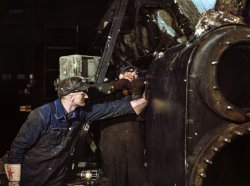
- Savannah: 1905
- ... not sure.
(The Gallery, Boats & Bridges, DPC, Railroads, Savannah) ... Posted by Dave - 08/09/2012 - 1:19pm -
![Savannah: 1905 Circa 1905. "The docks at Savannah." 8x10 inch dry plate glass negative, Detroit Publishing Company. View full size.
Is something amiss?Looks like there has been a derailment in the middle of the street.
FinallyA Pepsi-Cola sign.
Interesting shipCabins all around, but the way it is riding high in the water it seems to wait for bulk cargo as well. I wonder what it was and how it got stowed on board. No big conspicuous cargo hatches I could see.
Re: Interesting shipI posted a link to the photo on the Southern Railway Historical Society Yahoo group, and one of the members, Bob Hanson, a resident of Georgia, posted the following comment:
"The ship on the left taking coal appears to be either the City of Atlanta or the second City of Columbus (sister ships) of the Ocean Steamship Company of Savannah, a subsidiary of the Central of Georgia Railway."
Steam and Sail.Looks like the need to get that coal onboard to stop the listing to port! Not too much cargo goes on board this ship, only one noticeable cargo hatch forward towards the bow and only one crane to service it. And yes this ship does have sails as well. You can see a furled sail on the aft mast. Back in those days sails were breakdown insurance and used to help supplement steam power.
Savannah Docks, Detroit's finished productA 1904 postcard from the Detroit Photographic Company, titled, "Ocean Steamship Co's Docks, Savannah, Ga." from the New York Public Library Collection.
The faded message is dated March 30, 1906, and reads:
"Margaret & Irene, Arrived here this morning, we had a fine trip, been doing Savannah all day. We found it a lovely place and the weather like July in New York. Oh, it is just lovely. We take train to Atlanta tonight. Marie & John"
Potential Disaster In Savannah?I should have gone into a little more detail in my earlier comment. I really wish that smoke/steam was not obscuring the view of the locomotive as much as it is.
The tender appears to have derailed in the middle of the street. It looks as though it might have become detached from the engine. If so, and the water supply to the engine was interrupted, then everybody in the area should be running for their lives. I've posted some photos to my Flickr site of a 1948 boiler explosion that illustrates what happens when a steam locomotive runs out of water while the firebox is hot:
www.flickr.com/photos/michaeljy/3514234654
Also, notice that something has happened to the boxcar on the left side of the street, causing its load to shift and push its door out at the bottom. It looks like it might be loaded with bales of cotton. This poses a great dilemma for the railroad, since the door is barely hanging on and could fall off at any time. Those things are heavy. The car is half blocking the street, and it can only be moved with the greatest care, perhaps it can't be moved at all until the problem is fixed.
Meanwhile, all of this has blocked the rail access to this entire area, meaning that until these problems are solved, these extremely busy docks cannot be serviced.
Sleek That passenger/packet freighter sure has the sleek lines of that time. I like that architecture! It must have taken a long time to shovel all that coal from the barges into the bunkers of the ship.
[Coaling was accomplished with a mechanical conveyor, seen here in its raised position. - Dave]
I didn't notice the conveyer. That will speed things up a lot but the end is really nasty like using the grain legs in Buffalo, NY.
I can't decide if I like the ships more or the mishmash of rooflines in this photo!
Coaling at SavannahAs one always interested in the early 20th century coal economy (e.g. Berwind's Eureka Coal), any chance for an application of ShorpyZoom™ on the coal barges in this photo?
Gone To HistoryI tried finding this location, but the port of Savannah has changed so much that it is impossible. This area is likely under where the Talmadge Bridge now is.
Re: Coaling at SavannahWhat a dirty and labor-intensive job that was! Looks like there might be as many as a dozen or so men on that barge next to the ship, including one at the bottom of the ladder. There is no sign of any motorized vessel in the area, so I guess they had to use a combination of wenches and lines from the ship, along with sheer manpower, to maneuver the barges around as they were emptied.
The mechanical bucket, scuttle, collier, or whatever it was called, looks as though it had to be filled manually in the barge (as opposed to a clamshell-type contraption). Even with that many hands working, moving that much coal had to be a back-breaking task. But I guess people back then were accustomed to such.
[If any wenches were used, it wasn't for coaling. - Dave]
Steady as she goesThe sails on the ship to the left were probably only used as a staysail to stop the boat from badly rolling in swells, as there seems to be lots of rigging and substantial shrouds to get in the way of efficiently using wind power as a backup if the engine conked out -- you wouldn't want all your passengers too seasick.
The Cadsbyis the vessel in the center of the picture opposite the liner in the foreground. In the Cadsby photo, the vessel seen in the background may be the same as in the original, not sure.
(The Gallery, Boats & Bridges, DPC, Railroads, Savannah)](https://www.shorpy.com/files/images/SHORPY_4a10456a1.thumbnail.jpg)
- Smoke and Steam: 1914
- ... Larger Map
(The Gallery, D.C., Harris + Ewing, Railroads) ... Posted by Dave - 08/10/2014 - 5:03pm -
![Smoke and Steam: 1914 Washington, D.C., circa 1914. "Covered train platforms of Union Station viewed from roof of the City Post Office at Massachusetts Avenue, with First Street N.E. seen along stone wall." At left is perhaps the main attraction of this view, one of the grittier sections of Washington, not usually captured in period photographs. 8x10 inch glass negative, Harris & Ewing Collection. View full size.
Herbert Prescott Pillsbury Flour and FeedsHerbert Prescott Pillsbury, born in Massachusetts on February 29, 1848, died in DC March 22, 1922.
His previous store was at the corner of 3rd Street and New York Avenue NE in Washington, several blocks from the building in this photo.
The road entering that tunnel would be H Street, and directly to the right of this point of view would be Union Station.
The location of the building advertising HP Pillsbury now houses building housing CNN's Washington bureau.
[The address of his establishment here is 54-58 H Street N.E. - Dave]
Gone for MetroThe large building and the smokestack to the left of the tracks and at least the track on the left were removed when the Metro subway was constructed. The building was the power plant for the station.
The stone wall is still there, though. The entire area where the tracks are to the right of the stone wall was filled in as part of the station construction project. That must have been quite a job in the days before modern earthmoving equipment.
[Steam shovels! - Dave]
On my way over!And I expect the highest prices for my junk.
Short StoriesThat row of strangely short buildings at left, including the livery stable, look like the victims of a grade-raising project. They seem to have lost most of their first floor facades when the street was raised, perhaps as part of the Union Station construction.
Ground level going upIn fact the area had gone through a huge grade-raising project around 1890, which resulted in the original B&O New Jersey Ave. station being mostly submerged, and a new waiting room being constructed along side it in 1889. This view shows the original portion to the left and the addition to the right.
The stone wallView Larger Map
(The Gallery, D.C., Harris + Ewing, Railroads)](https://www.shorpy.com/files/images/SHORPY-14752a.thumbnail.jpg)
- Badland: 1939
- ... "No."
(The Gallery, Landscapes, M.P. Wolcott, Mining, Railroads) ... Posted by Dave - 05/05/2019 - 12:05pm -
![Badland: 1939 September 1939. "Ducktown, Tennessee. Train bringing copper ore out of mine. Fumes from smelting copper for sulfuric acid have destroyed all vegetation and eroded the land." Medium format negative by Marion Post Wolcott for the Farm Security Administration. View full size.
Duplicate?This seems to be the same MPW photo posted under the caption, “The Wasteland” a couple days ago. Maybe this is a different image, as I have not compared them side by side.
[That would be less trouble than leaving a comment, wouldn't it? - Dave]
FumesThey didn’t do wonders for the Ducktown inhabitants either; a Navy shipmate was from Ducktown, and he had major COPD at age 35, followed by a fatal heart attack a year later.
Not a resortIt looks like the land is still scarred. Here's an overhead view of the area northeast of Ducktown, near the Burra Burra mine. While the area has some vegetation, it still looks pretty bare. I wouldn't go near the lake to the west.
Now?I've seen a lot of things on Shorpy but the devastation seen here is astonishing. It looks to be many many square miles no doubt in all directions from the mine. I'm wondering what it might look like now, was there recovery?
To State the ObviousThis photo has a happy choo-choo that seems not to know the sorrows of air laden with sulfuric acid. The other doesn't.
51 Years LaterI drove through Ducktown in 1990. It didn't look anything like this.
Road sign said, "Ducktown, A quacking nice town."
Lasting scarsAbout 1978 I drove a cousin from Knoxville to an interview for a teaching position in nearby Copper Hill. The school sat all alone on a hilltop, with a 360-degree view very much reminiscent of this image. The superintendent who conducted her interview asked her if she "really wanted to commit to a place that looks like this?" She is eternally grateful to him for that question, because the answer was a resounding "No."
(The Gallery, Landscapes, M.P. Wolcott, Mining, Railroads)](https://www.shorpy.com/files/images/SHORPY-8c10632a.thumbnail.jpg)
- Colossus: 1904
- ... and men were men!
(The Gallery, Boats & Bridges, DPC, Railroads) ... Posted by Dave - 05/28/2011 - 2:58am -
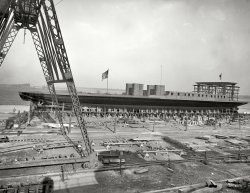
- City Gas: 1912
- ... to liven things up!
(The Gallery, Detroit Photos, DPC, Railroads) ... Posted by Dave - 10/21/2014 - 9:30am -

- Potter House: 1907
- ... called "mounting blocks." - Dave]
(The Gallery, DPC, Railroads) ... Posted by Dave - 07/29/2012 - 6:11pm -
![Potter House: 1907 Saginaw, Michigan, circa 1907. "Dr. Henry C. Potter's residence." 8x10 inch dry plate glass negative, Detroit Publishing Company. View full size.
The house knows how to accessorizeI love the windows and awnings. You don't see windows all dolled up like that anymore. Not on the outside anyway.
I'd live thereBut only if I could afford a housekeeper. And she better do windows, too.
Southern ExposureBefore air conditioning was common, south facing windows were often equipped with such shades.
TranquilityI look at this photo and say to myself, "The world has gotten too d@mn complicated." To sit on this porch in 1907 with a glass of lemonade and the evening paper, perhaps I would give up the comforts and technology of 2011. For back in 1907, if something had to be done or someone had to be contacted, it could just wait until tomorrow.
"Henry C. Potter"
Bathroom SuicideJan 5, 1909, N.Y. Times.
Dr. Potter's son:
HENRY C. POTTER Jr. A SUICIDE; Michigan Banker Was Suffering from Nervous Depression.
DETROIT, Mich., Jan. 4. -- Henry C. Potter, Jr., of the People's State Bank of this city, Secretary and Treasurer of the Flint Pere Marquette Railroad from 1884 to 1900, and a prominent figure in financial circles of Michigan, committed suicide to-day in the bathroom of his residence by shooting himself through the head.
A Wealthy ManAnd did he ever call his daughter's beau "That son of a Saginaw fisherman"?
Dr. Potter (1823-1909)Dr. Henry C. Potter's greatest accomplishment was the building and management of the Flint and Pere Marquette Railroad, which he undertook along with his father-in-law. He also formed and ran the Savings Bank of East Saginaw, from 1872 until the year of this photo. According to his biography in the "History of Saginaw County," "In his beautiful home, at Jefferson and Holland Avenues, he was a prince of hosts, courteous, hospitable, and ever thoughtful of the comfort and pleasure of his guests."
Voldemort IvyHe who shall not be named is creeping up the side of the house.
What's missing todayCraftmanship. The skill and artistry to produce intricate and quality wood products today is uncommon and we are the poorer for it.
Henry Camp Potter 1823-1909Born at Utica, New York, on January 14, 1823; died at San Ysidro Ranch near Santa Barbara on April 3, 1909, three months after his son Henry Jr. committed suicide.
He had led a full and interesting life, counting among his friends newspaper editor Horace Greeley, US Secretaries of State William H. Seward and James G. Blaine, and poet John Greenleaf Whittier. Before he died, he was one of the last remaining people to have heard Daniel Webster speak. Although he was a physician, getting his MD degree from Albany Medical College in 1844, Dr. Potter practiced medicine less than ten years. In 1852, he went into the public works construction business with his father-in-law, Samuel Farwell. That connection brought him to Saginaw in 1859 where he oversaw the building of the Flint and Pere Marquette Railroad. Dr. Potter served as treasurer, general manager and vice-president of that railroad until his retirement in 1891. In addition, he was instrumental in establishing the first salt company in the area, served on various bank boards and was conspicuously active in Saginaw civic affairs.
Dr. Potter was 86 when he died, old enough to have survived his wife of nearly 59 years, Sarah, and all four of their children. Helen died in 1864; James in 1879; William, president of the Long Island Railroad, in 1905; and, finally, Henry Jr., vice-president of the People’s State Bank of Detroit, by his own hand in 1909. It was said that last death likely did much to hasten Dr. Potter’s end.
1404 S. Jefferson Ave.This is 1404 S. Jefferson Ave near the corner of Jefferson and Holland. This entire block no longer exists today.
Watch your buggy step pleaseBetween the two hitching posts near the front porch is a square stone buggy step. They still survive here and there when not in the way such as mow strips between a sidewalk and the street.
[Also called "mounting blocks." - Dave]
(The Gallery, DPC, Railroads)](https://www.shorpy.com/files/images/4a22424a.thumbnail.jpg)
- Base Station: 1906
- ... Anyone know when they changed over?
(The Gallery, DPC, Railroads) ... Posted by Dave - 06/18/2015 - 10:58am -
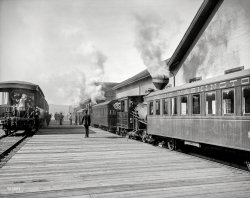
- Brockton, Mass. Train Station: c.1905
- ... View full size.
(ShorpyBlog, Member Gallery, Railroads) ... Posted by D_Chadwick - 02/03/2010 - 9:13am -
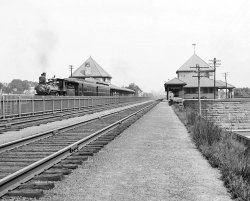
- Moving Pictures: 1900
- ... smooth. (I speak from experience.)
(The Gallery, DPC, Railroads) ... Posted by Dave - 09/20/2013 - 1:44pm -
![Moving Pictures: 1900 "1899 or 1902. Lackawanna photo car." Detroit Photographic's rolling studio-darkroom-showroom. 8x10 inch glass negative. View full size.
The futureWhat an interesting photo. I wonder if these people had the foresight of these photos being invaluable to future generations or was this just a business/hobby type venture ? Either way simply amazing !
Cheers.
Wonder if they slept there, tooFrom past Shorpy encounters, this is a famous railcar. With the ladies and child shown, I wonder if it also served as a rolling residence for the owners.
With the likely photo chemical fumes, it probably wouldn't have been conducive to living aboard, but it was a clever and modern way of doing business.
Mr. DPCLooks like William Henry Jackson himself on the rear platform holding the camera.
Morris and Essex RailroadApparently this car really belonged to the Morris and Essex Railroad, which was leased by the Lackawanna for roughly 80 years. Note the "M&E" to the far right of "Lackawanna."
BallastThe DL&W was a blue chip anthracite hauling carrier and extremely profitable. It prided itself on its physical plant, even down to the point of maintaining "razor" edge ballast along it main line tracks.
Posed rocksNo ordinary railroad ballast is that neat.
The colors of natureThose would be black, white, and gray, right?
[They were until DPC colorized their post cards and prints. -tterrace]
BallastI wonder if the rocks were placed that way to prevent water from eroding the tracks. I've never seen a ballast arrangement quite like that.
CoalUngraded coal of various sizes most likely in that tender: those gigantic chunks had to be hand-shoveled by the fireman into the firebox constantly. Possibly the one car consist was not as demanding fuelwise as a regular train of several cars. Nevertheless, it was hot as Hades labor during the summer, but brutally cold, in that open cab, in the winter season.
About that ballastI suspect that this photo was made at a station. The smoothness of the dirt path along the tracks suggests this. It was desirable to keep ballast out of walkways, because plain dirt is safer to walk on. People often twist their ankles while walking on ballast. Also, it is VERY difficult, sometimes impossible, to pull those big baggage carts over ballast, especially when they're loaded down with baggage, mail, and express. Station personnel make their jobs much easier by keeping the surfaces over which they have to pull those things smooth. (I speak from experience.)
(The Gallery, DPC, Railroads)](https://www.shorpy.com/files/images/SHORPY_4a16390a.thumbnail.jpg)
- Working Lunch: 1943
- ... or in front of a camera.
(The Gallery, Jack Delano, Railroads) ... Posted by Dave - 07/15/2009 - 7:43am -
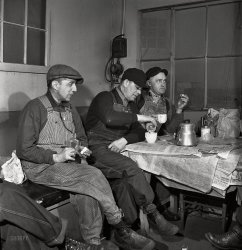
- General Excitement: 1919
- ... View full size.
(The Gallery, D.C., Harris + Ewing, Railroads, Streetcars, WWI) ... Posted by Dave - 08/29/2012 - 2:12pm -
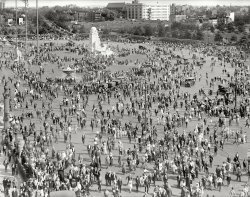
- Central Mexicano: 1891
- ... Santa Rosa . - Dave]
(The Gallery, Boats & Bridges, Railroads, W.H. Jackson) ... Posted by Dave - 04/27/2018 - 2:25pm -
![Central Mexicano: 1891 One of William Henry Jackson's "mammoth plate" exposures, made using 18x22 inch glass negatives, a massive view camera, assorted assistants, pack animals and a mobile darkroom that he hauled around by rail with chartered locomotives. This image comes from a number of 8x10 copy negatives exposed in the 1890s from the original 18x22 mammoth plates, which evidently are too big or fragile to scan.
1891. "Mexican Central Railway -- bridge over the Santa Rosa River." 8x10 glass plate made from an 18x22 negative by William Henry Jackson. View full size.
Where is this?Today, I can find no "Santa Rosa River" listed inside the nation of Mexico. Perhaps names have changed.
[Maybe those tricky Mexicans changed it to Rio Santa Rosa. - Dave]
(The Gallery, Boats & Bridges, Railroads, W.H. Jackson)](https://www.shorpy.com/files/images/SHORPY-4a03886a.thumbnail.jpg)
- Sinking the Tunnel: 1910
- ... 7,860 feet.
(The Gallery, Boats & Bridges, DPC, Railroads) ... Posted by Dave - 08/14/2012 - 12:53pm -
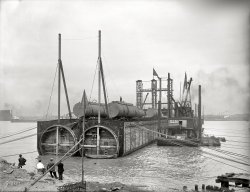
- Bustling Boonton: 1900
- ... as a sideline.
(The Gallery, Boats & Bridges, DPC, Railroads) ... Posted by Dave - 10/25/2017 - 10:54am -
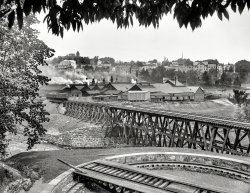
- Rio Grande: 1940
- ... she was scrapped the next year.
(The Gallery, Railroads, Russell Lee) ... Posted by Dave - 09/05/2018 - 3:03pm -
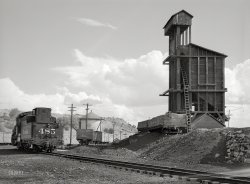
- State of New York: 1910
- ... hulls to me.
(The Gallery, Boats & Bridges, DPC, Railroads) ... Posted by Dave - 10/30/2012 - 2:45pm -
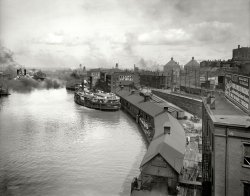
- Fast Food: 1943
- ... stay warm when it is cold.
(The Gallery, Jack Delano, Railroads) ... Posted by Dave - 02/07/2014 - 3:19pm -
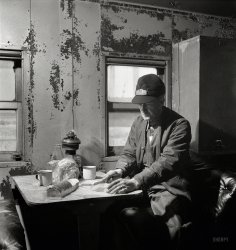
- Pocono Depot: 1905
- ... the building of Rt. 611.
(The Gallery, DPC, Horses, Railroads) ... Posted by Dave - 04/04/2018 - 10:53am -
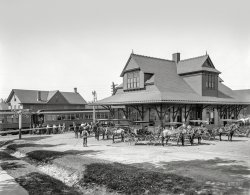
- Train Christening: 1929
- ... Darr. - Dave]
(The Gallery, D.C., Harris + Ewing, Railroads) ... Posted by Dave - 04/05/2013 - 12:06pm -
![Train Christening: 1929 July 14, 1929. Washington, D.C. "Ten-year-old Ellen Page Eaton will break a bottle of Potomac River water on the locomotive of a new Pennsylvania Railroad train this morning at 11 o'clock in the Union Station and christen it 'The Senator.' Little Miss Eaton is the daughter of John Eaton, crack engineer of the railroad, who is veteran of 28 years." More of the festivities first glimpsed here. Harris & Ewing Collection glass negative. View full size.
Ready when you are, CBIt looks like this might not have been the first take.
WhoopsYeah, looks like that Potomac River water didn't quite make it to the locomotive! Oh well, the thought was there.
Shoes and aplomb!I like the gent to the right of little Ellen Page Eaton, holding his hat with aplomb and trying become the center of attention. And look at his fashionable shoes!
As Jimmy Durante would say"Everybody wants to get into the act." The woman behind Miss Eaton and to her right in the picture is quite intriguing. And lovely. And elegant in her cloche hat and beads. The only thing prettier than a pretty woman is a pretty woman with a pretty hat.
Senator David I. WalshThe gent at the left-end shaking hands looks to be Senator David I. Walsh, of Massachusetts. Below is the final bit of the article from the previous post.
Washington Post, July 14, 1929.
… Among those who will attend the ceremonies are Senator David I. Walsh, of Massachusetts, District Commissioner Proctor L. Dougherty, Charles W. Darr, president of the Washington Chamber of Commerce, and the Rev. Shera Montgomery, chaplain of the House or Representatives. Alan B. Smith, general passenger agent of the railroad, who came here from Cleveland on July 1, is in charge of arrangements. Secretary of the Navy Charles Francis Adams and Secretary of Commerce Robert P. Lamont also have been invited to attend.
[The man between the hand-shakers is Charles Darr. - Dave]
(The Gallery, D.C., Harris + Ewing, Railroads)](https://www.shorpy.com/files/images/SHORPY_35484a.thumbnail.jpg)
- Powerhouse: 1906
- ... 13th Street in downtown Gulfport.
(The Gallery, DPC, Railroads) ... Posted by Dave - 08/14/2014 - 10:58am -
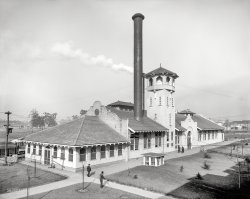
- Dangerous Crossing
- ... [Cattle guard. - Dave]
(ShorpyBlog, Member Gallery, Railroads) ... Posted by pabrown - 09/22/2011 - 12:11am -
![Dangerous Crossing Railroad crossing near McCook, Nebraska, around 1932. View full size.
I Give Up!Just past the crossing, on either side of the tracks are wooden things supported by posts with some sort of mat running between them between the tracks. What the heck is that for?
[Cattle guard. - Dave]
(ShorpyBlog, Member Gallery, Railroads)](https://www.shorpy.com/files/images/dangerouscrossingNE30s.thumbnail.jpg)
- Willow Springs: 1900
- ...
My Father's Predecessor? There are two railroads that run through Willow Springs. I'm guessing that this is the Santa ... Thank you for wonderful picture.
(The Gallery, DPC, Railroads) ... Posted by Dave - 11/13/2012 - 1:13pm -
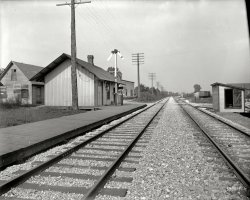
- C&P: 1906
- ... class GL.
(The Gallery, Cleveland, DPC, Mining, Railroads) ... Posted by Dave - 10/28/2018 - 4:24am -
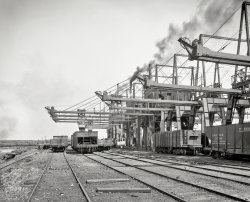
- Infrastructure: 1910
- ... 1910." - Dave]
(The Gallery, Detroit Photos, DPC, Railroads) ... Posted by Dave - 08/21/2012 - 4:52pm -
![Infrastructure: 1910 Detroit circa 1910. "Excavating for the new Union Station." A century later, the mammoth Michigan Central Station that eventually rose here still stands, if just barely. Note the two "moonlight tower" carbon arc lamp standards in the distance. 8x10 inch glass negative, Detroit Publishing Company. View full size.
Short Handled ShovelHated by laborers everywhere through the years. They appear in numerous folk and blues songs and the dislike is justified. I had to use one in a summer job as a kid and they are back breakers.
Evolution of earthmovingThis photo shows the past and the future of earthmoving: men shoveling the earth to the steam-powered shovel at the left of the photo.
But no bulldozers. Perhaps diesel/gas engines had not yet developed a power/weight ratio suitable for the needs of a bulldozer - but you had the idea on the front of locomotives: the cow catcher (and snow plow).
Everyone wore a hat, but no protective headgear. Why wear a vest during such strenuous activity?
Re: Short Handled shovelsThe trick is to take small shovel-loads, quickly. Too often, one tries to make the job easier by taking big "bites." Harder work, and less effective in the long run! What my dad always referred to as "a lazy man's load."
One goes up, another comes down.It looks like the building to the right just suffered a fire on the second floor.
How Are The Mighty FallenHere is a website showing the degradation of this once-magnificent structure.
http://www.seedetroit.com/pictures/mcsweb/
Track JacksIn the foreground, on the wooden planking there are two track jacks and a pair of "Texas Toothpicks" used to operate them. The ones I've encountered were rated at 100 tons, I on the other hand wasn't.
Well EmployedForty four men working. Today: possibly two for the same job.
Real ManpowerAlthough the topic is "excavating," it appears these men are moving gravel or road base off the flatcars and spreading it as a foundation. There is a similar running pile alongside the tracks on the right that is being attacked. Regular Shorpy readers know about the evolution of the steam shovel, which is working its way along the distant bank, whose curvature reflects the swing of the shovel arm. Presumably the weather is brisk enough to dress warmly.
I Believe in the Communion of SaintsAre the two fellows in the foreground "waterboys" (or perhaps more appropriately, watermen) for the crew? If so, it appears the fellow holding the ladle is an unhappy customer, who seems to be a little suspicious of the cleanliness of their wares. In 1910 I suppose they weren't as keen on hygienic issues and had no qualms about sharing the common cup with their fellow workmen.
Date is incorrectGround was broken May 1912, there is a photo set from insurance company Manning Brothers that resides in the Avery Collection at Columbia University NYC in the Warren and Wetmore Collection.
[Excavation had commenced at least by the spring of 1910. Below, headlines from May 16 and Oct. 17, 1910. Also, "circa 1910" does not necessarily mean "in 1910." - Dave]
(The Gallery, Detroit Photos, DPC, Railroads)](https://www.shorpy.com/files/images/4a23700a.thumbnail.jpg)
- The Senator: 1929
- ... 1955:
(The Gallery, D.C., Harris + Ewing, Politics, Railroads) ... Posted by Dave - 04/20/2013 - 8:53pm -
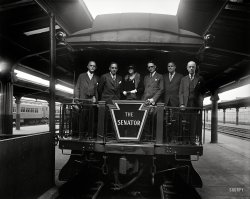
- Penn Station: 1912
- ... before it had been erected.
(The Gallery, DPC, NYC, Railroads) ... Posted by Dave - 07/30/2018 - 9:34am -
